翻译组绩效考核暂行办法(doc 7页)
翻译考核指南
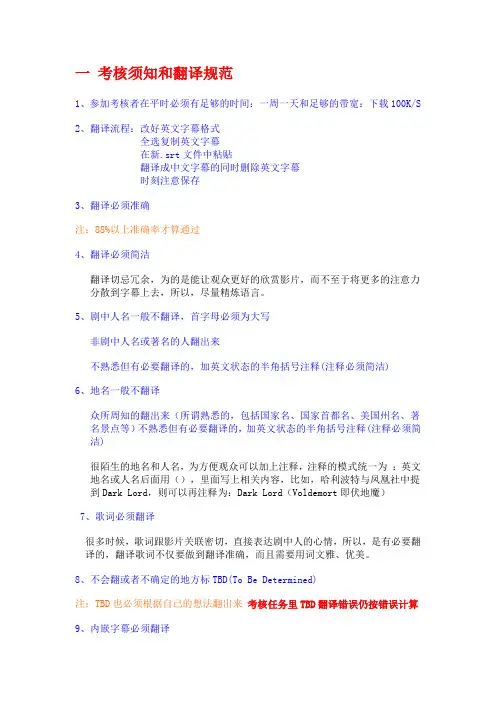
一考核须知和翻译规范1、参加考核者在平时必须有足够的时间:一周一天和足够的带宽:下载100K/S2、翻译流程:改好英文字幕格式全选复制英文字幕在新.srt文件中粘贴翻译成中文字幕的同时删除英文字幕时刻注意保存3、翻译必须准确注:88%以上准确率才算通过4、翻译必须简洁翻译切忌冗余,为的是能让观众更好的欣赏影片,而不至于将更多的注意力分散到字幕上去,所以,尽量精炼语言。
5、剧中人名一般不翻译,首字母必须为大写非剧中人名或著名的人翻出来不熟悉但有必要翻译的,加英文状态的半角括号注释(注释必须简洁)6、地名一般不翻译众所周知的翻出来(所谓熟悉的,包括国家名、国家首都名、美国州名、著名景点等)不熟悉但有必要翻译的,加英文状态的半角括号注释(注释必须简洁)很陌生的地名和人名,为方便观众可以加上注释,注释的模式统一为:英文地名或人名后面用(),里面写上相关内容,比如,哈利波特与凤凰社中提到Dark Lord,则可以再注释为:Dark Lord(Voldemort即伏地魔)7、歌词必须翻译很多时候,歌词跟影片关联密切,直接表达剧中人的心情,所以,是有必要翻译的,翻译歌词不仅要做到翻译准确,而且需要用词文雅、优美。
8、不会翻或者不确定的地方标TBD(To Be Determined)注:TBD也必须根据自己的想法翻出来考核任务里TBD翻译错误仍按错误计算9、内嵌字幕必须翻译注:内嵌字幕即在画面中出现,但未在英文字幕中给出的字幕。
遇到内嵌字幕时,英文字幕不做修改,在中文字幕中给出翻译,同时加上相应的时间轴。
时间轴加法:在附近复制一条轴,序号任意,改动时间轴的数值使之符合画面,注意别改得和前后时间轴重叠了10、文件命名格式中文字幕:影片名.***-***(句数,例1-100).****(你的名字).chs.srt英文字幕:影片名.***-***(句数,例1-100).****(你的名字).eng.srt11、提交要求必须在24小时内提交,从接到任务开始计时一份英文字幕(就是发给你的,需要改格式,*****部分为听译,需补全了)一份中文字幕(就是你翻译的,注意格式)还有领取考核任务邮件中要求的个人简介其余字幕、片源都不要将中、英文字幕和个人简介用WinRAR打包(压缩文件名为QQ号码+QQ昵称+领取考核任务时间)发送至指定邮箱:scgtest@邮件名称:QQ号码+QQ昵称+领取考核任务时间12、一般在一周内邮件回复考核结果13、考核通过,做任务可以得到●完成一部任务,奖励20威望,200圣元,1个工作组内部积分,1个贡献度●法定长假,3倍工资●为优秀者颁发字幕组内部勋章●根据积分不同,享受不同的等级待遇●志同道合的朋友●能力的提高●作品的流传注:无实际经济收入二格式规范英文字幕格式: 序号时间轴英文字幕空行注:必须保持这样的格式,否则会显示错误1、字幕必须整理到一行上去,即一个时间轴下面仅能有一行字幕2、字幕前面的注释必须删掉,如下图红圈内的部分;如时间轴下仅有注释而没有需要翻译的字幕,则删除注释,保留空轴注:注释即位于小括号或者中括号中,不是人物对白的字幕3、<i>和</i>必须删除4、对话格式:- XXX - XXX短横杠后空一格,两句对话间空两格5、歌词格式:# XXX ##+空格+歌词+空格+#6、标点符号格式:●英文字幕里的逗号、句号、问号、感叹号、引号保留;“-”(连字符时不改) “--”“---”破折号改成“...”省略号●英文字幕里的逗号、句号、问号、感叹号等标点后空一格,句首省略号删除,句中省略号后空一格●引号格式实例:the "five minutes for the cookies," the "no talking" signs posted everywhere前引号前空一格,后引号后空一格或者都不空保持一致●标点出现在句末则不需空格7、英文字幕中如出现乱码、英文单词缺失则必须补上;字幕中如出现i和I混用,或是I和L混用,则必须改正8、未提及的特殊情况以看着舒服为宜注:上图左边为原始英文字幕,右边为修改后的英文字幕中文字幕格式:序号时间轴中文字幕空行注:必须保持这样的格式,否则会显示错误1、字幕必须整理到一行上去,即一个时间轴下面仅能有一行字幕。
翻译绩效考核指标
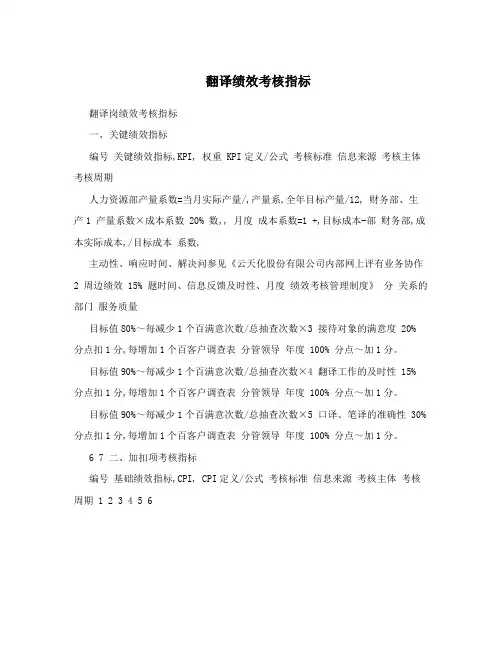
翻译绩效考核指标
翻译岗绩效考核指标
一、关键绩效指标
编号关键绩效指标,KPI, 权重 KPI定义/公式考核标准信息来源考核主体考核周期
人力资源部产量系数=当月实际产量/,产量系,全年目标产量/12, 财务部、生
产1 产量系数×成本系数 20% 数,, 月度成本系数=1 +,目标成本-部财务部,成本实际成本,/目标成本系数,
主动性、响应时间、解决问参见《云天化股份有限公司内部网上评有业务协作2 周边绩效 15% 题时间、信息反馈及时性、月度绩效考核管理制度》分关系的部门服务质量
目标值80%~每减少1个百满意次数/总抽查次数×3 接待对象的满意度 20% 分点扣1分,每增加1个百客户调查表分管领导年度 100% 分点~加1分。
目标值90%~每减少1个百满意次数/总抽查次数×4 翻译工作的及时性 15% 分点扣1分,每增加1个百客户调查表分管领导年度 100% 分点~加1分。
目标值90%~每减少1个百满意次数/总抽查次数×5 口译、笔译的准确性 30% 分点扣1分,每增加1个百客户调查表分管领导年度 100% 分点~加1分。
6 7 二、加扣项考核指标
编号基础绩效指标,CPI, CPI定义/公式考核标准信息来源考核主体考核周期 1 2 3 4 5 6。
绩效考核方案-(中英双语)
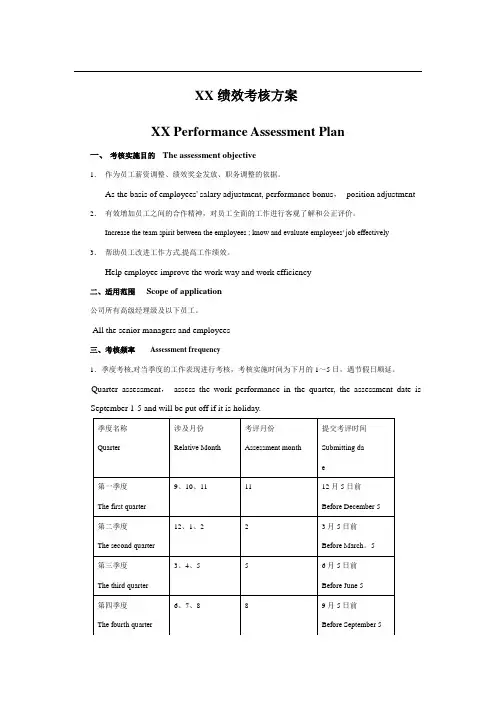
XX绩效考核方案XX Performance Assessment Plan一、考核实施目的The assessment objective1.作为员工薪资调整、绩效奖金发放、职务调整的依据。
As the basis of employees' salary adjustment, performance bonus,position adjustment 2.有效增加员工之间的合作精神,对员工全面的工作进行客观了解和公正评价。
Increase the team spirit between the employees ; know and evaluate employees' job effectively3.帮助员工改进工作方式,提高工作绩效。
Help employee improve the work way and work efficiency二、适用范围Scope of application公司所有高级经理级及以下员工。
All the senior managers and employees三、考核频率Assessment frequency1.季度考核,对当季度的工作表现进行考核,考核实施时间为下月的1~5日,遇节假日顺延。
Quarter assessment,assess the work performance in the quarter, the assessment date is September 1-5 and will be put off if it is holiday.四、考核内容Assessment content1.工作业绩work achievement2.工作能力work ability3.工作态度work attitude4.合作配合work cooperation5.自我提升self—improvement以上为基本考核内容,具体详情另见考核附件Above is the basic assessment content,the details is as the follow ’s assessment attachment五、评分对照Score compare考核分数对照表Assessment score form六、考核实施Assessment carrying out1.考核实施及考核对象配比Assessment carrying out and object matching备注:总部各部门负责人由CEO直接考核。
语言翻译团队绩效考核标准
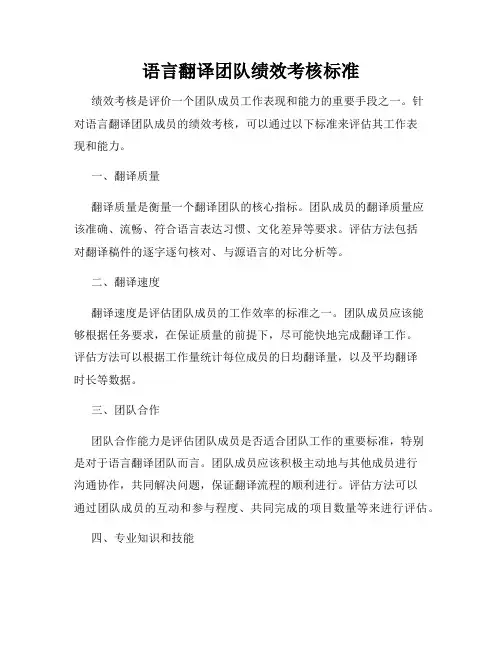
语言翻译团队绩效考核标准绩效考核是评价一个团队成员工作表现和能力的重要手段之一。
针对语言翻译团队成员的绩效考核,可以通过以下标准来评估其工作表现和能力。
一、翻译质量翻译质量是衡量一个翻译团队的核心指标。
团队成员的翻译质量应该准确、流畅、符合语言表达习惯、文化差异等要求。
评估方法包括对翻译稿件的逐字逐句核对、与源语言的对比分析等。
二、翻译速度翻译速度是评估团队成员的工作效率的标准之一。
团队成员应该能够根据任务要求,在保证质量的前提下,尽可能快地完成翻译工作。
评估方法可以根据工作量统计每位成员的日均翻译量,以及平均翻译时长等数据。
三、团队合作团队合作能力是评估团队成员是否适合团队工作的重要标准,特别是对于语言翻译团队而言。
团队成员应该积极主动地与其他成员进行沟通协作,共同解决问题,保证翻译流程的顺利进行。
评估方法可以通过团队成员的互动和参与程度、共同完成的项目数量等来进行评估。
四、专业知识和技能团队成员应该具备丰富的专业知识和技能,包括对不同领域的专业词汇和术语的熟悉程度、翻译软件的使用熟练度、语言表达能力等。
评估方法可以通过对团队成员进行专业知识测试、技能考核以及语言表达能力的口头或书面评估等方式。
五、问题解决能力团队成员在工作中会遇到各种问题和挑战,能够及时解决问题并提出合理有效的解决方案是评估团队成员能力的重要指标。
评估方法可以通过对团队成员在工作中遇到的实际问题进行分析和解决过程的评估,以及对解决方案的合理性和可行性进行评估。
六、客户反馈客户反馈是评估团队成员工作表现的重要依据之一。
团队成员应该能够与客户建立良好的沟通和合作关系,获取客户的反馈意见,并及时对反馈意见进行整理和改进。
评估方法可以通过客户满意度调查、接收客户反馈的数量和质量等指标来进行评估。
以上是语言翻译团队绩效考核的一些标准,通过全面、客观地评估团队成员在翻译工作中的表现,可以有效提升团队整体的工作质量和效率,实现团队绩效的最大化。
绩效考核办法绩效考核制度中英文
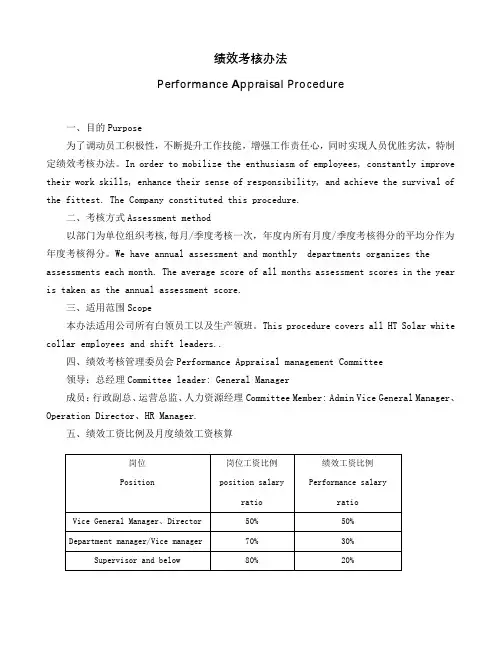
绩效考核办法Performance Appraisal Procedure一、目的Purpose为了调动员工积极性,不断提升工作技能,增强工作责任心,同时实现人员优胜劣汰,特制定绩效考核办法。
In order to mobilize the enthusiasm of employees, constantly improve their work skills, enhance their sense of responsibility, and achieve the survival of the fittest.The Company constituted this procedure.二、考核方式Assessment method以部门为单位组织考核,每月/季度考核一次,年度内所有月度/季度考核得分的平均分作为年度考核得分。
We have annual assessment and monthly departments organizes the assessments each month. The average score of all months assessment scores in the year is taken as the annual assessment score.三、适用范围Scope本办法适用公司所有白领员工以及生产领班。
This procedure covers all HT Solar white collar employees and shift leaders..四、绩效考核管理委员会Performance Appraisal management Committee领导:总经理Committee leader: General Manager成员:行政副总、运营总监、人力资源经理Committee Member: Admin Vice General Manager、Operation Director、HR Manager.五、绩效工资比例及月度绩效工资核算月度绩效工资=工资标准*绩效工资比例*月度绩效得分*100%Monthly performance salary = standard salary * performance salary ratio * monthly performance scores /100六、考核周期:Assessment cycle月度考核:自每月1日到月末最后一天。
English绩效考核管理规定
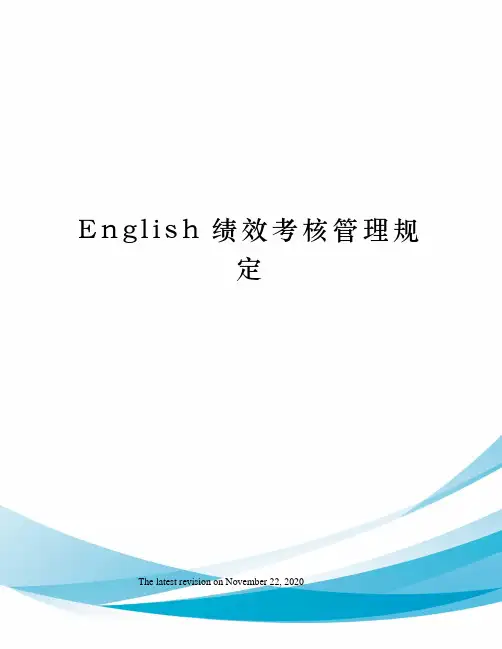
E n g l i s h绩效考核管理规定The latest revision on November 22, 2020Li Ning Co.,Ltd Performance Assessment Management SystemRevised in Dec.,2010Table of ContentsChapter 1 General ProvisionsArticle 1 Scope of ApplicationThis performance assessment management system applies to all employees of Li Ning’s holding companies and joint stock companies in Mainland China, including Li Ning (China) Sports Goods Co., Ltd, Li Ning Sports (Shanghai) Co., Ltd, ,Li Ning Sports Goods Commerce (Beijing) Co., Ltd, Shanghai Yueao Sports Goods Co., Ltd, Shanghai Yidong Sports Development Co., Ltd, Shanghai Z-DO Sports Goods Co., Ltd, LOTTO Sports Goods Co., Ltd, Li Ning Sports (Tianjin) Co., Ltd etc.Other subsidiaries including Li Ning Sports (Hong Kong) Co., Ltd,Li Ning Sports Technology Development (Hong Kong) Co., Ltd, Li Ning Sports USA, Inc,Li Ning Sports Singapore Pte Ltd, Guangdong Yueao Sports Development Co., Ltd, Foshan Li Ning Gymnastics School Services Co., Ltd, other brands and sales companies as well as newly established companies refer to the rules.Article 2 Purpose of Performance Management2.1Performance goals breakdown: Based on performance management system, breakdown the company’s strategic goals and annual operational goals at different levels in order to ensure that the goals for departments and individual employees support company goals effectively;2.2Performance results improvement: Carry out performance goals setting,performance process guiding, performance appraisal and feedback performance management system to ensure the continuous improvement of the performance of individual employees and teams;2.3Building a communication platform: Performance management delivers a completeand easy-to-use management tool for the communication between management members and employees in terms of goals setting, work performance and future development, encouraging the timely communication between them during the assessment cycle;2.4Create performance-oriented culture: Through performance goals-orientedperformance assessment, conduct an objective assessment of employees’ performance, grant rewards or impose punishment, raise the initiatives of employees, and intensify the culture characterized by excellent performance;2.5Upgrading performance-related abilities: Through developing and implementingIndividual Development Plan (IDP) based on the leadership competency model and professional level, improve the abilities of all employees step by step, facilitate the realization of performance goals and help identify excellent employees.Article 3 Performance Management Principles3.1Set sensible goals: In the process of breaking strategic goals down intoperformance goals of individual employees, take into account the longitudinal conformity and latitudinal synergies, identify clear focuses and set sensible goals.3.2Recommend positive encourage: Performance management encourages employees tokeep breaking established goals and their own abilities, inspires them to achieve excellent performance, and gives full affirmation and rewards to those excellent performers;3.3Differentiate performance levels: Through the whole-process management of theall performance all indicators, set performance assessment criteria tailored for Li Ning’s manageme nt conditions to differentiate different levels of performance and reflect different levels of performance results and rewards;Chapter 2 All-round Performance Management System andDuties DivisionArticle 4 All-round Performance Management SystemAll-round performance management consists of two parts: all-indicators management and whole-process management, including performance, abilities and individual development, being a cyclic management from goals setting, process guiding to assessment and feedback.Article 5 All-round performance —— All indicators management5.1 All-indicator performance management comprises performance management system, which takes KPI as the core, and ability development, which takes leadership/professional skill as the core. It involves performance results and the ability needed to achieve the expected performance results.上图中文字:全指标管理:All-indicator management 愿景:Vision业绩导向:Performance Orientation 能力导向:Ability orientation战略目标:Strategy goals 价值观:Value部门目标:Department goals 资质模型:Competency model个人关键业绩指标:Individual key performance indicator能力潜力评估:Ability potential assessment个人发展计划:Individual Development Plan(IDP)5.2Performance management which takes KPI as the core:5.2.1 Key Performance Indicator(KPI): It is a management indicator tomeasure the performance of an employee in a performance cycle, beingthe basis of the company’s performance management system.Thesetting of KPI helps drive the implementation of company strategyand guide the direction of employees working.5.2.2 Key Development Indicator (KDI): It is an indicator set for managementmembers of department managers or above, in order to draw theattention of managers to the team building and employees development.Through the purposeful introduction, coaching and guiding foremployees, help them achieve their performance goals.5.2.3 Observation indicators: For the supervision and risk control of somebusiness results, we just assess the observation indicators and theresults are not included into the final assessment results.Observation indicators include company observation indicators andindividual observation indicators.Company observation indicators: Depending on the company focuses at a certain stage, choose the corresponding indicators fortarget employees to observe and the target employees are identifiedby the company.Individual observation indicators: Depending on the focuses at the current stage, the examiner and the examinee discuss and set theindividual observation indicators in order to carry out and monitorthe execution of the indicators.5.3 Capability assessment management: Performance management does not only focus on the performance, but also on capability to achieve continuous excellent performance and competency behaviors. With the leadership competency models and professional skill as the core, train all employees to develop, assess and give feedback to their competencies and qualities in a planned way to raise their competencies step by step and guarantee the sustainable competitiveness of the company. Capability assessment management includes capability assessment based on leadership competency models and professional skill and development-based potential assessment. In particular,5.3.1Leadership assessment and development: Leadership competency acts asthe important basis for leadership development. The companyhighlights the concept of “every employee in Li Ning is a leader”.The leadership assessment, based on “Li Ning leadership competencymodel”, includes four parts: leading self, leading business, leadingteams and leading others (see Attachment 1).Review, assess, train andfollow-up the employees’ lea dership competency behaviors on aregular basis. See training materials for details.5.3.2 Professional skill assessment and development: Professional skillsdiffer depending on the different positions/tasks, reflecting theprofessional skills needed for an employee to do his work. Review,assess, train and follow-up the professional eligibility of anemployees on a regular basis to improve their efficiencies andachievements. See Notes on Professional Skills and PositionsDescription for the requirements on Professional skills.5.3.3 Potential assessment: Potential reflects the possibility of anemployee to develop higher or toward other areas in the future. Byassessing an employee’s potential, observe his or her space forfuture development and growth as the reference for personnelpreparation and promotion. For details, see Attachment 2:Top 10Factors for Evaluating Leadership Potential in Li Ning5.3.4Individual development plan (IDP): Based on an employee’s performance,leadership, results of professional skills assessment, as well as hisor her knowledge and experience, work out an IDP for the next yeartaking into account work plan and individual’s career developmentneeds.(See Attachment 3).Article 6 All-round Performance - Whole-process ManagementWhole-process management refers to the cyclical whole-process management from performance indicators setting, process follow-up coaching and rewards and punishment after assessment. In particular,6.1Indicator setting: It includes performance goals setting, ability goalssetting, working out of individual development plans, and reaching an agreement on goals setting;6.2 Follow-up coaching: It includes regular review of performance goalsexecution and employees coaching, giving support and coaching to solve the problems, and ensuring the correct work direction and timely resolution of problems;6.3 Rewards and punishments: This includes performance review, assessment,communication as well as the implementation of rewards and punishment.上图文字:全过程管理:Whole-process management指标设定:Indicators setting 业绩目标:Performance goals能力目标:Ability goals 个人发展计划:Individual development plan目标设定沟通:Communication for goals setting评估奖惩:Rewards and punishment after assessment绩效总结:Performance review 绩效评估:Performance assessment绩效沟通:Performance communication 绩效结果应用:Application of performance results跟踪辅导:Follow-up coaching期中回顾:Midterm review 辅导跟进:Coaching and follow onArticle 7 Duties Division7.1Examiner –responsible for setting, managing and evaluating employeeperformance goals, in particular:7.1.1Set performance and ability goals and individual development plantogether with employees: Based on the company’s strategic goals andwork focuses, break down and work out the performance goals of eachbusiness unit and subordinate employees; communicate the goals withemployees and reach an agreement with the setting of performance goals;7.1.2Coach employees to accomplish goals and feedback: Assist and coachemployees to implement the performance goals; help employees upgradeabilities and accomplish performance goals and achieve individualdevelopment;7.1.3Conduct performance assessment and feedback: Depending on performancecycle, perform an interview with employees and conduct assessment, andgive the real and objective feedback to employees. Affirm theexcellent performance behaviors of employees, coach them in theaspects needing improvement and propose clear and specificrequirements, work out an improvement plan together with individualemployees.7.1.4Rewards and punishments: According to the performance assessmentresults, a supervisor puts forward the opinions on the rewards andpunishments with individual employees and communicates the informationto them.7.1.5Identify the key direction for the next stage: supervisors andemployees together discuss the direction, focuses and goals for thenext stage; the supervisors motivate the subordinates to be willingand able to achieve the goals, and provide necessary resources support.7.2 Examinee –the object of performance management which undertakes thefollowing duties:7.2.1Confirm goals: Set, clarify and confirm with the examiner theperformance goals and schedule, while determining ability developmentgoals and individual development plan etc;7.2.2Performance realization: An employee makes efforts to realize thegoals effectively, display commitments and responsibilities inaccordance with company competency behavior criteria. During thisprocess, communicate with the examiner, seek feedback and assistancewith the problems, confirm the results for the current stage and thedirection for the next stage, and ensure the achievements of the finalperformance goals.7.2.3Self assessment and summarization of performance: through theinterview with the examiner or other ways, summarize theimplementation of individual performance, make self assessment of thecurrent performance, review the IDP and propose the points forimprovement in the next stage; seek feedback and get to know theexpectation of the supervisor, and work out an improvement plantogether.Chapter 3 All-round Performance Management –Performance Indicator SettingArticle 8 Breakdown and Setting of Performance GoalsSetting of performance indicators includes Key Performance Indicators (KPI), Key Development Indicators (KDI) and observation indicators. It breaks down the strategic goals of the company level by level and assigns them to each position, representing a process of communication and reaching an agreement between the supervisors and the employees with work goals and considering these work and goals as the basis to evaluate the performance of employees at the end of each stage. The setting of performance goals includes the following:8.1Break the strategic goals of the company down at the level of business unit:in accordance with the annual operation plan of the Group, break its annual goals down at each brand, system and business unit, ensure the support of each business unit to the Group work; when necessary, organize discussion and communication to coordinate the synergies between indicators in all aspects, and form performance contract of head of each business unit;8.2 Goals of each business unit is broken down at the level of departments: Headof each business unit communicates with Dept managers and break down the annual goals of the business unit at each department to ensure the support of departments to the work of their business unit; coordinate the synergies between departments, and form performance contract of department managers;8.3 Break down the departmental goals at the level of employees: Based on thekey tasks and positions of each department, department manager or designated examiner, together with employees, determine the performance goals and completion criteria, form Employees’ Key Performance Indicators;8.4Setting of Key Development Indicators: They are set by the company based onthe development focuses of the company at each stage and the actual situation of each business unit;8.5Setting of observation indicators: Based on the focuses at each stage, taskswhich need the attention of the examinees can be set as observation indicators. Observation indicators can be divided into company level, whichis set forth by the company, and individual level, which is set forth by examiner and examinee after discussion.Article 9 Contents of Key Performance IndicatorsKey performance indicators include indicator type, indicator, weight, target value assessment method, examiner and name of examiner. Please refer to Attachment 4 for KPI Template.9.1Indicators: Key indicators which are determined by examiner and examineethrough discussion and reflect the current focuses. They can be result indicators (directly reflecting the business results of the company, departments and individuals and their performance and showing the success or failure in a straight way); or process indicators (reflecting the actions taken to achieve the result indicators, or the examination items during the process) on which an examinee may have impact;9.2Weight: Determine the weight of each indicator based on the current focusesand the sum of each weight should be 100%;9.3 Target value: goals to be attained according to the indicators at currentstage. Performance examination goals should be explicit, specific and measurable, i.e., specify the work quantity and quality and specific requirements;9.4 Assessment methods: They are methods to calculate or evaluate the score ofeach indicator. Usually there are formula for calculating quantitative indicators and result indicators;9.5 Examiner: It is divided into first examiner (usually immediate supervisors)and second examiner depending on work requirements and subordination;9.6 Name of examiner: Name of the first examiner/second examiner;Article 10 Principles for Setting Key Performance Indicators10.1 SMART principle: Setting performance indicators shall follow the principleof SMART:Specific: Performance goals shall specify the work contents andassessment ways;Measurable: Performance goals shall be measurable through objectivecalculation or subjective assessment, and the cost, time,investigation/calculation difficulties shall be in a controllable range(to avoid select indicators hard to achieve or needing overly high cost);Attainable: Performance goals shall be controllable within the work scopeof the examinee, and attainable through making necessary efforts;Relevant: Performance goals shall be highly relevant to the work of theexaminees;Time bound: Performance goals shall have specific time limit, i.e., theremust be specific results in a specified period, normally the examinationcycle. Alternatively, considering the characteristics of positions setthe more detailed time frame within the examination cycle.10.2 Timely renewal: Performance goals shall be changeable. They shall beadjusted in a timely way when any change of work focuses in the company or departments in a performance cycle takes place;10.3 Principle of longitudinal support: When breaking down the goals at thelevels of business units, departments and employees, pay attention to the longitudinal support of the subordinate to the upper-level unit to guarantee the realization of strategic goals of the company and the support of individual goals to company goals;10.4 Principle of latitudinal coordination: Breakdown of indicators shall alsotake into account the latitudinal coordination between systems and departments. Communication meeting shall be organized and held to determine the core indicators of each department to guarantee the latitudinal coordination and collaboration.10.5 Principle of keeping certain weight: The weight of a single indicator shallnot be lower than 5% and number of indicators shall not be more than 10 to maintain the attention of examinee to each indicator.Article 11 Setting of Ability AssessmentBased on the company’s leadership, professional level and potential, and taking into account the current focuses and the abilities of the examinee, select the corresponding items of abilities needed for individual positions of employees. In particular:11.1 Leadership setting: Leadership competency is the important basis for thecompany to develop leadership and it is set according to Band which anexaminee belongs to;11.2 Setting professional level: Professional level reflects the professionalskills needed for an employee to do his or her job. It is set according to the position which an employee takes;11.3 Potential assessment: Potential reflects the possibilities of an employeedeveloping towards higher level or other directions. It is set in Top 10 Factors for Evaluating Leadership Potential in Li Ning.For specification to fill in, please refer to other relevant regulation. Article 12 Setting of Individual Development PlanIndividual Development Plan is filled in by taking into account work requirements, employee’s current ability and willingness for individual development. It is drafted by the examinee. When interviewing an examinee, the examiner coaches the examinee, providing ability assessment opinions and development suggestions. For specification to fill in, please refer to other relevant regulation.Chapter 4 All-round Performance Management-Process Coaching and CommunicationArticle 13 Purpose of Performance Process Coaching and Communication Process coaching and communication refers to look for solutions through tracking the completion of performance goals, following up progress and finding difficulties and problems. It supports and coaches the examinee and integrates resources in order to ensure the correct work direction and finishing work within the time limit.。
翻译绩效考核指标
翻译绩效考核指标
翻译岗绩效考核指标
一、关键绩效指标
编号关键绩效指标,KPI, 权重 KPI定义/公式考核标准信息来源考核主体考核周期
人力资源部产量系数=当月实际产量/,产量系,全年目标产量/12, 财务部、生
产1 产量系数×成本系数 20% 数,, 月度成本系数=1 +,目标成本-部财务部,成本实际成本,/目标成本系数,
主动性、响应时间、解决问参见《云天化股份有限公司内部网上评有业务协作2 周边绩效 15% 题时间、信息反馈及时性、月度绩效考核管理制度》分关系的部门服务质量
目标值80%~每减少1个百满意次数/总抽查次数×3 接待对象的满意度 20% 分点扣1分,每增加1个百客户调查表分管领导年度 100% 分点~加1分。
目标值90%~每减少1个百满意次数/总抽查次数×4 翻译工作的及时性 15% 分点扣1分,每增加1个百客户调查表分管领导年度 100% 分点~加1分。
目标值90%~每减少1个百满意次数/总抽查次数×5 口译、笔译的准确性 30% 分点扣1分,每增加1个百客户调查表分管领导年度 100% 分点~加1分。
6 7 二、加扣项考核指标
编号基础绩效指标,CPI, CPI定义/公式考核标准信息来源考核主体考核周期 1 2 3 4 5 6。
绩效考核方案-(中英双语)
XX绩效考核方案XX Performance Assessment Plan一、考核实施目的The assessment objective1.作为员工薪资调整、绩效奖金发放、职务调整的依据。
As the basis of employees’ salary adjustment, performance bonus, position adjustment 2.有效增加员工之间的合作精神,对员工全面的工作进行客观了解和公正评价。
Increase the team spirit between the employees ; know and evaluate employees’ job effectively3.帮助员工改进工作方式,提高工作绩效。
Help employee improve the work way and work efficiency二、适用范围Scope of application公司所有高级经理级及以下员工。
All the senior managers and employees三、考核频率Assessment frequency1.季度考核,对当季度的工作表现进行考核,考核实施时间为下月的1~5日,遇节假日顺延。
Quarter assessment, assess the work performance in the quarter, the assessment date is September 1-5 and will be put off if it is holiday.四、考核内容Assessment content1.工作业绩work achievement2.工作能力work ability3.工作态度work attitude4.合作配合work cooperation5.自我提升self-improvement以上为基本考核内容,具体详情另见考核附件Above is the basic assessment content, the details is as the follow ’s assessment attachment五、评分对照Score compare考核分数对照表Assessment score form六、考核实施Assessment carrying out1.考核实施及考核对象配比Assessment carrying out and object matching备注:总部各部门负责人由CEO直接考核。
办公室翻译绩效考核指标
能力类型
权重(100%)
得分
加权得分
核心能力
专业技能
35
效率
20
创新能力
15
团队合作
15
书面沟通
15
合计
100
项目
态度类型
认真完成任务
30
及时准确向上级汇报工作
20
虚心好学,要求上进
20
有责任感,愿意承更多的责任
15
是否遵守上级指示
15
合计
100
30
季度绩效考核表
直接上级
加强信息收集工作质量和效率,为公司提供急需资料
3
外宾来访口译
接待到总部及子公司来访的外宾
20
季度绩效考核表
直接上级
提高翻译工作水平,保证公司形象
4
内部满意度
见部门满意度调查表
10
相关部门评价,人力资源部汇总
人力资源部
提高内部服务质量,加强内部信息沟通与协作
2、办公室翻译能力/态度要求列表
办公室翻译绩效考核指标
1、办公室翻译KPI指标表
指标编 号
KPI
KPI说明
权重(100%)
计算方法
信息来源考核目的1 Nhomakorabea资料翻译质量
翻译各部门送达的中英文产品说明书、参考资料、外事信件、商标宣传等英文资料等
40
季度绩效考核表
翻译的资料
加强资料翻译工作的准确性,为公司提供质量好的相关资料
2
信息收集
查找、整理资料,阅览室管理
翻译绩效考核指标1翻译kpi指标表指标编号kpikpi说明权重100计算方法信息来源考核目的1资料翻译质量翻译各部门送达的中英文产品说明书参考资料外事信件商标宣传等英文资料等40季度绩效考核表翻译的资料加强资料翻译工作的准确性为公司提供质量好的相关资料2信息收集查找整理急需资料阅览室管理30季度绩效考核表直接上级加强信息收集工作质量和效率为公司提供急需资料3外宾来访口译接待到总部及子公司访的外宾20季度绩效考核表直接上级提高翻译工作水平保证公司形象4内部满意度见部门满意度调查表10相关部门评价人力资源部汇总企发部提高内部服务质量加强内部信息沟通与协作2办公室翻译能力态度要求列表项目能力类型权重100得分加权得分核心能力专业技能35效率20创新能力15团队合作15书面沟通15合计100项目态度类型认真完成任务30及时准确向上级汇报工作20虚心好学要求上进20有责任感愿意承更多的责任15是否遵守上级指示15合计100
翻译组绩效考核暂行办法
翻译组绩效考核暂行办法1.目的为了树立迷信、规范的业绩评价体系,明白月度业绩考核顺序,使翻译组员工的任务失掉客观公正的评价,进而可以树立富有鼓舞和竞争力的人员考核和提升系统,将绩效与报酬相结合,充沛调发开工的任务能动性,提高任务绩效。
2.适用范围本方法适用于公司翻译组全体员工业绩考核与评价〔试用期员工除外〕。
3.翻译人员构成和业务流程3.1翻译人员构成翻译部门人员由审译、排版、小组长和译员构成;3.2翻译业务流程〔1〕原文经过J北京软件自动翻译全文,由各小组外局部工修正;〔2〕小组外部应组织互审,组长担任组内审译,然后将译文交给审译人员审译;〔3〕排版组担任修正图表,创立,图表由各组长担任审译;〔4〕每周五中止翻译,组织讨论本周翻译内容,有新词或分歧停止列表汇总,对翻译进度和存在的效果予以说明并构成报告,提交翻译组担任人、公司指导和日本瑞萨相关人员。
〔5〕翻译进程中一切词句均以瑞萨词典为规范。
4. 翻译质量跟踪评价4.1依据审译人员对译员所翻译文章的错误类型和数量,对译文停止质量跟踪评价;4.2 翻译的错误类型有以下8种〔详细的描画见附件1〕:〔1〕翻译内容错误;〔2〕技术术语运用不准确;〔3〕技术术语运用前后不分歧;〔4〕翻译内容遗漏;〔5〕语法错误;〔6〕词句不迟滞;〔7〕表达不当;〔8〕其他方面。
4.3 错误率的计算赋予每种错误类型一定的系数,各种类型错误数量乘以对应系数后相加,再除以被审核译文字数,即为该译文的错误率,详细公式如下:译员错误率=∑〔错误数量*系数〕/被审字数审译错误率=〔漏审数量+错审数量〕/被审字数4.4 审译人员对译文审核终了,填写翻译水平全体评价表〔见附件2〕,并将审译稿交回各组组长,由组长担任统计并填写翻译质量评价表〔见附件3〕,并布置译员依据审核结果对译文停止修正后提交。
5.考核5.1依据译员翻译的文字数量和错误率,对译员停止考核;5.2 翻译组员工的工资组成:工资总数=基础工资+福利+提成基础工资依据员工的任务才干和任务业绩评定〔详细方法另定〕,福利按公司一致规范执行;5.3译员每翻译1000字的规范提成为20元,依据错误率的上下停止调整,详细比率和提成规范见附件4;5.4排版人员每排版1000字的规范提成为5元,图表翻译规范提成为每个图表5元。
- 1、下载文档前请自行甄别文档内容的完整性,平台不提供额外的编辑、内容补充、找答案等附加服务。
- 2、"仅部分预览"的文档,不可在线预览部分如存在完整性等问题,可反馈申请退款(可完整预览的文档不适用该条件!)。
- 3、如文档侵犯您的权益,请联系客服反馈,我们会尽快为您处理(人工客服工作时间:9:00-18:30)。
翻译组绩效考核暂行办法(doc 7页)
部门: xxx
时间: xxx
制作人:xxx
整理范文,仅供参考,勿作商业用途
翻译组绩效考核暂行办法
1.目的
为了建立科学、规范的业绩评价体系,明确月度业绩考核程序,使翻译组员工的工作得到客观公正的评价,进而能够建立富有激励和竞争力的人员考核和晋升系统,将绩效与报酬相结合,充分调动员工的工作能动性,提高工作绩效。
2.适用范围
本办法适用于公司翻译组全体员工业绩考核与评价(试用期员工除外)。
3.翻译人员构成和业务流程
3.1翻译人员构成
翻译部门人员由审译、排版、小组长和译员构成;
3.2翻译业务流程
(1)原文通过J北京软件自动翻译全文,由各小组内部分工修改;(2)小组内部应组织互审,组长负责组内审译,然后将译文交给审译人员审译;
(3)排版组负责修改图表,创建FM BOOK,图表由各组长负责审译;(4)每周五停止翻译,组织讨论本周翻译内容,有新词或分歧进行列表汇总,对翻译进度和存在的问题予以说明并形成报告,提交翻译组负责人、公司领导和日本瑞萨相关人员。
(5)翻译过程中所有词句均以瑞萨词典为标准。
4. 翻译质量跟踪评估
4.1根据审译人员对译员所翻译文章的错误类型和数量,对译文进行质量跟踪评估;
4.2 翻译的错误类型有以下8种(具体的描述见附件1):
(1)翻译内容错误;
(2)技术术语应用不准确;
(3)技术术语应用前后不一致;
(4)翻译内容遗漏;
(5)语法错误;
(6)词句不通畅;
(7)表达不当;
(8)其他方面。
4.3 错误率的计算
赋予每种错误类型一定的系数,各种类型错误数量乘以对应系数后相加,再除以被审核译文字数,即为该译文的错误率,具体公式如下:译员错误率=∑(错误数量*系数)/被审字数
审译错误率=(漏审数量+错审数量)/被审字数
4.4 审译人员对译文审核完毕,填写翻译水平整体评估表(见附件2),并将审译稿交回各组组长,由组长负责统计并填写翻译质量评估表(见附件3),并安排译员根据审核结果对译文进行修改后提交。
5.考核
5.1根据译员翻译的文字数量和错误率,对译员进行考核;
5.2 翻译组员工的工资组成:
工资总数=基础工资+福利+提成
基础工资根据员工的工作能力和工作业绩评定(具体办法另定),福利按公司统一标准执行;
5.3译员每翻译1000字的标准提成为20元,根据错误率的高低进行调整,具体比率和提成标准见附件4;
5.4排版人员每排版1000字的标准提成为5元,图表翻译标准提成为每个图表5元。
短篇翻译的提成另计,标准按译员的提成标准执行;
5.5组长的提成标准为组内译员的平均提成标准的1.1倍;审译人员每1000字的标准提成为8元;
5.6 员工连续3个月的翻译量达到10万字/月以上,并且错误率均低于 1.5‰,则基础工资增加200元;连续3个月的错误率均高于5‰,则基础工资减少200元;
5.7日本瑞萨公司出具的审译报告,将作为评价翻译组全体员工整体绩效和员工能力的重要参考依据,也是员工定级和晋升的主要参考指标。
6.附则
6.1本办法自2007年4月1日开始实施;
6.2本办法由人力资源部负责解释,翻译组配合实施。
附件1:翻译错误类型及系数
附件2:翻译水平整体评估表
附件3:翻译质量跟踪表
附件4:翻译提成标准一览表
附件1
翻译错误类型及系数
译员翻译错误率R = ∑(各类型错误*比例系数)/ 被审字数
附件2
翻译水平整体评估表。
